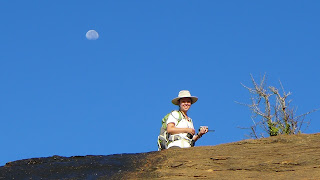Here’s a quick look at how we spend our days:
We are up by 5am, eating a quick breakfast and having the
essential cup of Kenyan coffee. We pack lunch, fill our CamelBaks with water,
and double-check our gear for baboon work. By 5:45 we’re on the road to see
baboons, just as the sun is creeping over the horizon. Luckily that means that
we get to see some spectacular sunrises.
And if we're lucky we get a nice clear view of Mount Kenya.
Lately we have not been so lucky, but have a pretty great view of the storms that are about to hit.
Regardless of the weather, after ~40 min in the truck we arrive in the area of our two
focal troops. Although UNBP has six troops under observation year-round, we are
focusing on the Pumphouse Gang and Enkai. Why only 2 of the troops? Successful
behavioral field research results from a delicate balance in data collection.
While we are always aiming to collect as much data as possible, we have to be
careful to collect good quality data. In many cases in behavioral research,
rich data on fewer individuals is actually better than sparser data on more
individuals. We are currently just observing adults and sub-adults in our two
troops, rotating through the individuals to get as even coverage as possible.
Each day we go to the troop that we did not go to the previous day.

Once we have driven to the study area, we head to the target
troop’s sleeping site. Each troop has a number of available sleeping sites in
the area, mostly large rock formations that keep them safe from leopards,
lions, and other risks at night. Each night we get texts from trackers on all
troops as to where each troop goes for the night, so we have a pretty good idea
where they will be in morning. That doesn't mean that the troop will be at the
sleeping site when we arrive, some days the troop is off and moving by 6 am and
it will take some time to find them and/or catch up. Usually we end up hiking
30-90 min to get to the troop, then we start our work day.
Our primary focus for data collection right now is social
behavior. For each individual, we want to know who they are associating,
grooming, fighting, and mating with. This will give us information about the
relationships between individuals and, eventually, how they influence the
overall dynamic of the group.
To get this data we collect behavior in 3 ways:
1. Focal
follows: We follow one individual (our focal animal) for 15 minutes, recording
everything that the focal does and the identities of all individuals that
interact with the focal.
2. Nearest
neighbor scans: We record the distances of the nearest male and female every 5
minutes for the focal animal during the focal follow.
3. Ad libitum
behavior: Although it might not seem like it at first, baboons have a low rate
of important social behaviors such as aggression and mating. If we only relied
on focal follows, we would miss out on many of these interactions (I am
beginning to think that the chances of a fight breaking out the minute after I
finish a focal follow is way above chance). To give us a better picture of what
is happening between individuals, we record every instance of these interesting
social behaviors.
All of this behavior is recorded on a handheld device in the
field and uploaded into our computer databases each night at camp.
Getting back to our schedule, once we find the baboons, the
observers split up and start collecting focal follows. Right now that is how we
spend each day, just moving down our list of focal animals, getting as many
focals as possible. I will admit that at times it can get a little boring. Some
animals have a tendency to sleep or eat for entire focals and at times you have
to wait for your focal animal to come down from a sheer rock face before you
can even begin a focal. But there is always something interesting going on in
the troop, it doesn’t take long before all observers become engrossed with the
drama that is baboon society.

Some of our latest news in the Pumphouse Gang is Buffalo’s
new baby boy, Yankee. Buffalo is the highest ranking female in the troop, she
is dominant over all other females. Anubis baboons, particularly females, are
obsessed with babies. So the new arrival of Yankee has led to almost incessant
baby greetings by all individuals that pass by Buffalo. Baby greetings often
consist of a bow-like movement to get the greeter’s face close the baby, soft
grunts, and lipsmacks. Not to anthropomorphize TOO much, but it is very much
like my greetings to my baby nephews and seems to be just as addictive!
After filling 5-9 hours with behavioral observation on the baboons, it’s time to head home. We unpack and restock our materials, upload data, shower, deal with any camp maintenance or chores, and get to work making dinner. It is not normally too long after dinner that we are ready for bed. We need to get some good sleep in before starting another day of baboon research.
.JPG)
.JPG)







.JPG)


















































